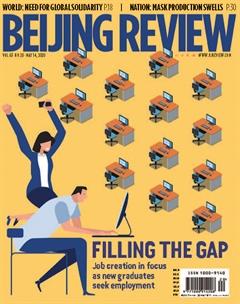Digital Responses
By Li Bo


While the prevalence of the novel coronavirus disease (COVID-19) is putting significant downward pressure on the world economy and reshaping global supply chains, it has also given a strong push to the digital economy based on the Internet, e-commerce services and cloud computing, and fueled the digitalization of traditional industries.
According to a report released by the UN Conference on Trade and Development on April 6, the development of digital technologies will enhance the risk-response capacity of global economies, while more people will enjoy the dividends brought about by bridging the digital gap.
Economic transformation
The program of the Digital Belt and Road was initially proposed at the First Belt and Road Forum for International Cooperation in Beijing in 2017 as part of the Belt and Road Initiative. The 2013-born initiative, consisting of the Silk Road Economic Belt and the 21stCentury Maritime Silk Road, aims to build a trade and infrastructure network connecting Asia with Europe and Africa along and beyond the ancient Silk Road trade routes.
In general, Chinese companies have played an important role in enabling digital transformation, helping other emerging market participants of the Belt and Road Initiative build digital infrastructure and develop related products and services. This has met local demands for mobile consumption, digital payment and inclusive fi nance, facilitated job creation and improved supply chains for small and medium-sized enterprises.
According to statistics obtained by the Digital Belt and Road Research Center, China Institute, Fudan University, 201 major Chinese companies in digital transformation- related fields have implemented 1,334 overseas investment and cooperation projects over the past two years, focused mainly on eight major sectors, namely e-commerce(85), communication infrastructure/5G networks (211), digital finance/fintech (136), smart cities (264), the industrial Internet(189), intelligent terminals (115), information technology services (88) and pan-entertainment/media and entertainment (236). Among them, 57 percent are associated with the Digital Belt and Road.
Regarding their regional distribution, there are 490 projects in Asia, accounting for 37 percent of the total. Projects in Central and Eastern European countries and Russia make up 12 percent, while those in Africa 7.7 percent.
Southeast Asia is the focus region in building the Digital Belt and Road. According to Chinas Ministry of Commerce, seven of the top 10 Belt and Road participants where Chinese enterprises have invested are in Southeast Asia. However, the digital economy of members of the Association of Southeast Asian Nations (ASEAN) is relatively underdeveloped, accounting for only 7 percent of the regional GDP, while that in China is 40 percent.

To promote the development of the digital economy, ASEAN has rolled out several plans, including the ASEAN E-Commerce Agreement and Digital Convergence Framework, initiated the ASEAN Smart Cities Network and welcomed international cooperation. Thus, ASEAN countries have strong incentives to cooperate with China on related projects.
Currently, the mobile payment service Alipay of Ant Financial, the fi ntech affi liate of Chinese e-commerce giant Alibaba, has been expanded to countries including Thailand, the Philippines, Malaysia and Indonesia. Alibaba spent $1 billion to acquire the leading Southeast Asian e-commerce platform Lazada in 2016, while JD.com, another major e-commerce business in China, cooperated with Central Group, Thailands largest retailer, to launch an online retail platform called JDCentral in 2017. In addition, Chinese companies led by Huawei are conducting extensive cooperation with several Southeast Asian countries to build smart cities, smart energy projects and 5G networks.
A new direction
As COVID-19 prevention and control become regular, the Digital Belt and Road can provide a new development direction such as using digital technologies to facilitate the resumption of production and social activities. From the Chinese experience, consented sharing of personal health status and travel information among regions via the QR health code system has played a positive role in finding close contacts of COVID-19 patients and tracking suspected cases.
A proposal submitted to the government by the German National Academy of Sciences Leopoldina in April said wearing masks and having a digital tracking platform and large-scale testing capabilities are the three necessary prerequisites for gradually restoring Germanys social mobility. At the same time, in Switzerland and the UK, pilot mobile phone applications that monitor the implementation of social distancing regulations have been launched.
Currently, the focus of the Digital Belt and Road is to help participating countries contain the COVID-19 pandemic. The outbreak has been brought under control in China. But since China is the worlds largest trader in goods and has extensive interactions with the outside world, only when other countries achieve prevention and control goals simultaneously, can peoples daily life and companies operation get back on the normal track.
In the next six to 12 months, there will be a peak of digital platform building to support health code certifi cation between countries in individual regions like China, the Republic of Korea (ROK) and Japan in East Asia, ASEAN members and EU nations. Next, in order to guarantee safe travel among regions, countries can provide access to data exchanges among different digital platforms and promote the process of cross verifi cation. It will be crucial to achieve interoperability among regional platforms and realize real-time cross inquiry. Eventually, these platforms will form seamless connectivity through online booking systems for hotels, airlines, railways, shipping companies and travel agencies in order to develop a real-time cross verification mechanism.

Even if vaccine research makes progress in the next 12 months, the manufacturing, delivery and vaccination process must be implemented in phases. Thus, large-scale virus screening and necessary prevention measures will last for some two to three years, during which vaccination records will be added to peoples personal health code fi le, together with their COVID-19 test results and mobility and socializing information. Therefore, the global information sharing platforms function will be further expanded, along with its data exchange networks.
Since the outbreak of the pandemic, the demand for Web conferencing, telecommuting, online education and e-government services has increased signifi cantly, meaning that the digital infrastructure needs to be greatly expanded, which will put great pressure on developing countries. On one hand, China can increase investment and provide affordable cloud services for neighboring countries and regions. On the other hand, it is feasible to create long-term fi nancing tools such as Digital Belt and Road infrastructure bonds and build data centers in individual regions and countries to facilitate their digital transformation.
Future solutions
Human society is becoming digital incredibly fast, which means more sensitive information from individuals and companies will be transmitted and processed online, making privacy and security protection, cybercrime crackdown and cyberattack response common issues for the international community. It requires countries adopt transparent rules and regulations and build a multilateral mechanism while building the Digital Belt and Road.
To achieve collaborative governance for the global digital economy, China should first cooperate with Japan, the ROK and ASEAN countries to improve the standards and norms of the Digital Belt and Road. They could build a cooperative mechanism, resolve disputes and cope with COVID-19 based on the ASEAN-China Joint Statement on Synergizing the Master Plan on ASEAN Connectivity 2025 and the Belt and Road Initiative, as well as the ASEANChina Leaders Statement on Smart City Cooperation Initiative.
It is essential to develop a more effective cyberspace regulatory framework and strengthen competition regulation in the digital services market. Standards for the cross-border transmission of data between China, Japan, the ROK and ASEAN countries should be formed, along with a mechanism for data resource sharing and cloud services and an international platform for dispute settlement. In addition, while advancing the Regional Comprehensive Economic Partnership process that includes 15 major Asia-Pacifi c economies, they should increase investment in talent training, enhance their digital construction capacity, and establish an emergency platform and a collaboration mechanism to jointly address cybersecurity issues.

